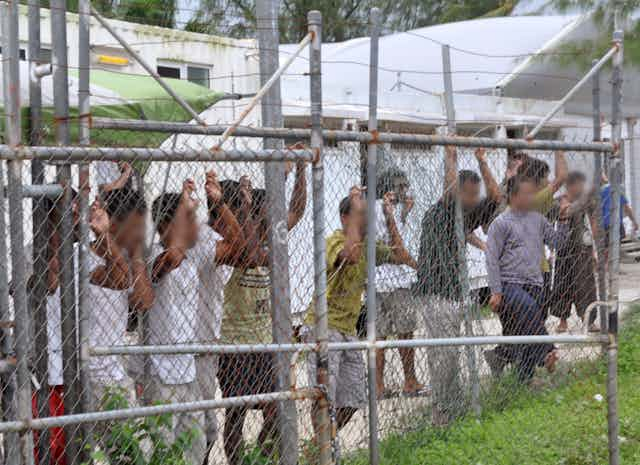The Keating government’s decision to introduce mandatory detention of asylum seekers in 1992 has long been recognised as a progenitor of the hardline policies that have been increasingly a feature of this fraught area of policy.
Kerry O’Brien asked Paul Keating about this in his recent interviews with the former Labor prime minister. Keating explained:
To be honest, it was not a great human rights issue for cabinet at the time.
Gerry Hand, a Left factional leader, was the immigration minister, Keating said, and it was taken for granted that “he would have the human rights issues covered”.
The National Archives of Australia today released selected key cabinet records for 1990 and 1991. A cabinet document of June 26, 1990, reveals that the journey to Nauru and Manus began several years earlier than 1992. The logic of the policy changes initiated by the Hawke government in mid-1990 has underpinned asylum seeker policy for much of the quarter-century since.
A background attachment prepared for cabinet explained:
Each applicant who is granted asylum in Australia displaces an applicant for humanitarian consideration overseas. Many applicants overseas are living in tenuous conditions in countries of refuge, have waited patiently in line to be assessed, and have claims for humanitarian resettlement which are far more urgent and compelling than the majority of cases considered in Australia.
The document does not use the term “queue-jumper”, but the concept is well and truly developed. It added:
We are seeing a growing trend worldwide of the jet-age asylum claimant.
Fears of a perfect storm
The numbers applying for asylum in Australia had grown in the recent past. From just 564 in 1988-89, applications rose to 3077 in 1989-90, up to the end of May. The backlog was estimated at six or seven years if applications were processed at the current rate.
These delays were likely to stimulate further – possibly frivolous – claims because asylum seekers would be able to continue living in Australia while they waited. A few boat arrivals had come from Cambodia, but most applicants for asylum had arrived with a valid visa.
Changes in the Australian economy, the international order, the ease and cost of transport, and local case law were creating the conditions for what Hand and his advisers saw as a perfect storm.

The development of an Australian education export industry was one problem, for international students sometimes claimed asylum. In 1989 the Hawke government had allowed Chinese students in Australia at the time of the suppression of pro-democracy demonstrations to remain in the country.
The government now proposed dividing students into those from high- and low-risk countries. This would be done on the basis of judgements (from the previous behaviour of visitors and students in each national group) about the likelihood that they would claim asylum.
Those from “high-risk countries” – which included Lebanon, Turkey, Poland, South Korea, Pakistan, Iran and China – would be subject to stringent checks and restrictions which did not apply to other applicants.
Developments in the international order were seen as contributing to the problem. These included civil wars in Lebanon and Sri Lanka, as well as the official clampdown in China. Australian officials also looked with concern on the looming end of British rule over Hong Kong in 1997, fearing that it, too, would lead to asylum claims.
‘Judicial activism’ added to alarm
Recent “judicial activism” was seen to have compounded the problem. This had made it easier to claim asylum in Australia, a trend that was:
… sending ‘beacon’ signals to overseas source areas and potentially disrupting the efficiency of controls over our Migration Program.
The cabinet submission explained:
The judicial model will certainly ensure justice, but only to those who have the price of a plane ticket and the ingenuity to get an Australian visa.
Australia was “reaching a point where most on-shore refugee applicants from a country perceived as politically unstable or possessing a limited commitment to human rights” would secure asylum and residency. This meant people from “at-risk countries” were able “to self-select themselves as de facto migrants”.
The document declared tartly:
The judicial model appears to accept that it is better for one hundred non-genuine claimants to get undeserved sanctuary in Australia, than for one genuine claimant to be ‘refouled’ to his or her country.
It is a measure of Hand’s desperation that the minister considered removing from the courts the power of judicial review in asylum seeker cases. Senior law officers, however, thought that there were alternatives to such a drastic step.
The basic direction recommended was instead to detach claims for protection from the issue of permanent residence. It is a distinction that remains a favourite among immigration ministers closer to our own times.
Asylum-migration policy linkage remains key
What was seen as at stake here? It was clearly not primarily Australia’s mainly offshore humanitarian program.

The nation had already experienced divisive debate over Asian migration to Australia earlier in the decade. In 1988, a report handed down by former ambassador to China Stephen FitzGerald had found a lack of public support for multiculturalism and an immigration policy insufficiently geared to national economic interests.
Politicians and officials increasingly recognised support for government policies on migration and settlement as fragile. The cabinet submission declared that any perception “that the government is not master of the inflow” would risk public support for migration policy in general. It might even produce “a dangerous public backlash against overseas-born Australians particularly those with origins outside Europe”.
Certainly, if public rhetoric is any guide, the idea of a nexus between strict government control of the asylum seeker intake and wider public support for migration and settlement policy remains at the heart of political consideration of such matters today.

